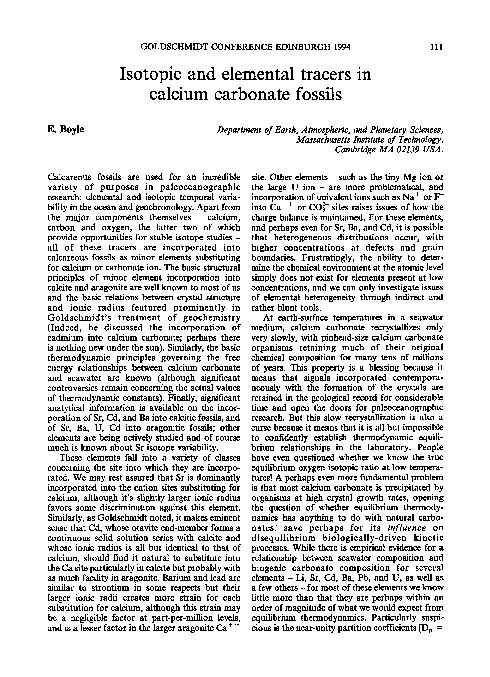Academia.edu no longer supports Internet Explorer.
To browse Academia.edu and the wider internet faster and more securely, please take a few seconds to upgrade your browser.
Isotopic and Elemental Tracers in Calcium Carbonate Fossils
Related Papers
Geochimica et Cosmochimica Acta
Calcium-aluminum-rich inclusions with fractionation and unknown nuclear effects (FUN CAIs): I. Mineralogy, petrology, and oxygen isotopic compositions2014 •
2016 •
Trace elements incorporation of certain trace elements like strontium (Sr) and magnesium (Mg) among others and their isotope composition in different CaCO3 polymorphs (e.g. calcite and aragonite) as archives provide valuable for proxy information, that can be used as important tools for reconstructing the paleo- environmental conditions of the oceans throughout time. However, data on Sr incorporation into inorganic precipitated CaCO3 (calcite and aragonite), Mg incorporation into aragonite and Sr isotopic fractionation during minerals formation are still very rare. In addition, literature values available concerning Ca isotopic fractionation between calcite and aqueous solution are discrepant to a certain extent, while on the other hand the data available concerning Ca isotopic fractionation between inorganic precipitated aragonite and aqueous solution are also scarce. In order to overcome this lag of information in this study calcite and aragonite were precipitated at three differe...
Journal of Geochemical Exploration
Origin of Ca in South Indian calcretes developed on metamorphic rocks2006 •
Calcrete profiles developed on Precambrian silicate rocks in south peninsular India are studied and compared in terms of mineralogical, chemical and isotopic composition. The aim of this study is to determine the origin of calcium and the processes governing the development of a minor economic deposit in different geomorphic settings. The investigation integrates observations from an outcrop to a microfabric scale and reveals that the origin of calcium is local and linked with the weathering of the minerals of the surrounding rocks. The CaCO3 precipitation occurs after vertical and lateral translocation in the slope system.
Chemical Geology
Isotopic tracers of the origin of Ca in a carbonate crust from the Middle Atlas, Morocco2001 •
Geochimica et Cosmochimica Acta
Calcium-isotope fractionation in selected modern and ancient marine carbonates2006 •
Science Advances
Calcium isotopic evidence for the mantle sources of carbonatitesThe origin of carbonatites—igneous rocks with more than 50% of carbonate minerals—and whether they originate from a primary mantle source or from recycling of surface materials are still debated. Calcium isotopes have the potential to resolve the origin of carbonatites, since marine carbonates are enriched in the lighter isotopes of Ca compared to the mantle. Here, we report the Ca isotopic compositions for 74 carbonatites and associated silicate rocks from continental and oceanic settings, spanning from 3 billion years ago to the present day, together with O and C isotopic ratios for 37 samples. Calcium-, Mg-, and Fe-rich carbonatites have isotopically lighter Ca than mantle-derived rocks such as basalts and fall within the range of isotopically light Ca from ancient marine carbonates. This signature reflects the composition of the source, which is isotopically light and is consistent with recycling of surface carbonate materials into the mantle.
Geochimica et Cosmochimica Acta
Rate-controlled calcium isotope fractionation in synthetic calcite2004 •
Christian-Muslim Relations A Bibliographical History Volume 21. South-western Europe (1800-1914) (Brill, 2024)
Memories of al-Andalus in 19th century SpainReconquista and Arab/Muslim Spain’ articulate the typically essentialist narrative of Spanish nationalism about medieval Iberia. While largely contradictory, they each arose out of the same political and ideological context and ran parallel through the 19th and most of the 20th centuries. In both paradigms, to which Arabists and historians alike assented, al-Andalus represented either a part of the eternal Spanish nation or its fiercest enemy, the anti-Spain whose destruction paved the way for building the nation.
RELATED PAPERS
Renaissance and Reformation
Nelson Novoa review of Stefano Villani Making Italy Anglican.2023 •
INTERNATIONAL JOURNAL OF CIVIL ENGINEERING AND TECHNOLOGY (IJCIET): IAEME
STUDY OF THE EFFICIENCY OF STONE COLUMNS IN SOFT CLAY: CONSIDERING THE EFFECT OF CLAY MINERALS IN SOIL2014 •
Göttinger Forum für Altertumswissenschaft
Andreas Zack, Rez. P. SANCHEZ, Foedus ictum. Les rites ... (2024), GFA 26,2023 •
2024 •
2019 •
Sleep Medicine
241 New Clinical Staging for Tonsillectomy in Adult Patients with Osa – Preliminary Results2009 •
Advances in Mathematics
Non-commutative Hopf algebra of formal diffeomorphisms2006 •
ournal of Logistics, Management and Engineering Sciences (JLMES)
Impacts of Standard Gauge Railway Project on Tanzania Economy Amidst and After Completion2023 •
HAL (Le Centre pour la Communication Scientifique Directe)
An pediculi, pulices et cimices sunt venena ? L'approche des poux, puces et punaises dans la production "vénénologique" de l'Occident chrétien, XIVe-XVe siècles2015 •
2011 •
Energy and Buildings
Yellow is green: An opportunity for energy savings through colour in architectural spaces2014 •
International Journal of Medical Science and Clinical Inventions
Training Need assessment of Anganwadi Workers of District Srinagar of Kashmir valley2017 •

 Ed Boyle
Ed Boyle